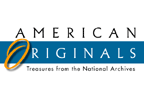
Press Kits: American Originals Traveling Exhibit

Traveling Exhibit: "American Originals" Treasures from the National Archives
- Press Release: The National Archives Takes "American Originals" on the Road
- Photo Gallery: Highlights of the Traveling Exhibition. Download publication-quality images of some of the documents in the traveling exhibition, including the six core documents and images of regional interest from each of the sites.
- Information on the "American Originals" Catalog
- View the Online Exhibit Hall version of "American Originals"
- Press Kit for the Washington, D.C. Exhibition of "American Originals" Displayed March 16, 2001-July 4, 2001.
- Factsheet on the National Archives and Records Administration
Note: All of the documents featured in "American Originals" are from the holdings of the National Archives. For prints, or for more information, contact the National Archives Public Affairs Media Desk.
The National Archives Takes
"American Originals" on the Road
Washington, D.C. … The Louisiana Purchase. The Emancipation Proclamation. Thomas Edison's patent for the "Electric Lamp—" These documents represent milestones in American history, and all are part of "American Originals," a new traveling exhibition from the National Archives and Records Administration. This major exhibition is scheduled to travel to nine cities, bringing some of the rarely-seen treasures in the holdings of the National Archives to people across the nation.
"American Originals" is currently scheduled to travel to the following locations:
- The New York Public Library, New York City, New York (Oct. 5, 2001-Jan. 5, 2002)
- The Peggy Notebaert Nature Museum, Chicago, Illinois (Feb. 8-April 28, 2002)
- Ohio Historical Center, Columbus, Ohio (May 24-Sept. 2, 2002)
- Jimmy Carter Presidential Library, Atlanta, Georgia (Sept. 27, 2002-Jan. 5, 2003)
- Union Station Kansas City, Kansas City, Missouri (Jan. 31-May 4, 2003)
- Witte Museum, San Antonio, Texas (May 31-Sept. 1, 2003)
- Los Angeles Public Library, Los Angeles, California (Oct. 4, 2003-Jan. 4, 2004)
- Museum of American Political Life, University of Hartford, Hartford, Connecticut (Jan. 30-May 9, 2004)
- Delaware Art Museum at the Bank One Center on the Riverfront, Wilmington, Delaware (Sept. 2-Oct. 17, 2004)
"American Originals" showcases original documents that have charted the course of American history. The exhibition is drawn from the vast holdings of the National Archives, which preserves and makes available to the public those records of the United States government that have been identified as having permanent value. These original documents are the raw stuff of history. They are physical links to the past - pieces of history in its most unprocessed form. While some of the documents announce their own importance with flourished signatures and wax seals, others are deceptively routine in appearance. All of them have passed through the hands of the most notable figures in our nation's history, and hold messages beyond their words.
In conjunction with "American Originals," the National Archives will also share one of its greatest treasures with the American people by sending the original, signed Emancipation Proclamation to each of the eight sites. To ensure its preservation for future generations, this fragile landmark document will be on special display for four days at each venue.
Archivist of the United States John Carlin said, "'American Originals' gives us an invaluable opportunity to share our nation's rich historical resources with Americans around the country. The traveling exhibition is scheduled to coincide with an extensive renovation of the National Archives Building in Washington, D.C. When we reopen the Rotunda in 2003, the Charters of Freedom will be more accessible to all Americans and our renovated building will have better public areas to showcase our nation's documentary heritage."
Highlights of the Traveling Exhibit: "American Originals" Treasures from the National Archives
"American Originals" includes original documents that have charted the course of American history. This online press kit features images of the documents that will be traveling to every venue, as well as one document that is of unique regional interest to each venue. For preservation purposes, the pages of a particular document or the version of that document may vary from site to site. Click on the thumbnail images for a high-resolution image of the document. For prints, or for more information, contact the National Archives Public Affairs Media Desk.
Core Documents
(These documents will travel to every site; due to conservation concerns,
different pages will be on display at different sites.)
- Voting record of the Constitutional Convention, 1787.
- Louisiana Purchase Treaty, April 30, 1803.
- The Preliminary Emancipation Proclamation, September 22, 1862.
- Emancipation Proclamation, signed by President Lincoln, January 1, 1863.
- Thomas Edison's patent application for an "Improvement in Electric Lamps," November 1, 1879.
- German Military Surrender, signed at the end of World War II, May 1945.
- John F. Kennedy's handwritten draft of his inaugural address, January 17, 1961.
Other Documents of Regional Interest
- New York: George Washington's first inaugural address, delivered in New York City, April 30, 1789.
- Chicago: Notebook recording the first controlled, self-sustaining nuclear chain reaction, December 2, 1942.
- Columbus: President Abraham Lincoln's nomination of Ulysses S. Grant, a native son of Ohio, to be Lieutenant General of the U.S. Army, February 29, 1864.
- Atlanta: President Jimmy Carter's draft, "Framework for a settlement in the Sinai," 1978.
- Kansas City: A note, in case of failure, written by Gen. Dwight D. Eisenhower on June 5, 1944. This document is on loan from nearby Dwight D. Eisenhower library.
- San Antonio: Credentials of the Honorable Sam Houston, Senator from Texas, February 21, 1846.
- Los Angeles: John Wayne's application for a commission with the Office of Strategic Services (OSS), 1943.
- Hartford: Opinion of the Supreme Court in United States v. The Amistad, March 9, 1841. The first court proceedings of this case took place in Hartford's Old State House.
Core Documents
Other Documents of Regional Interest














